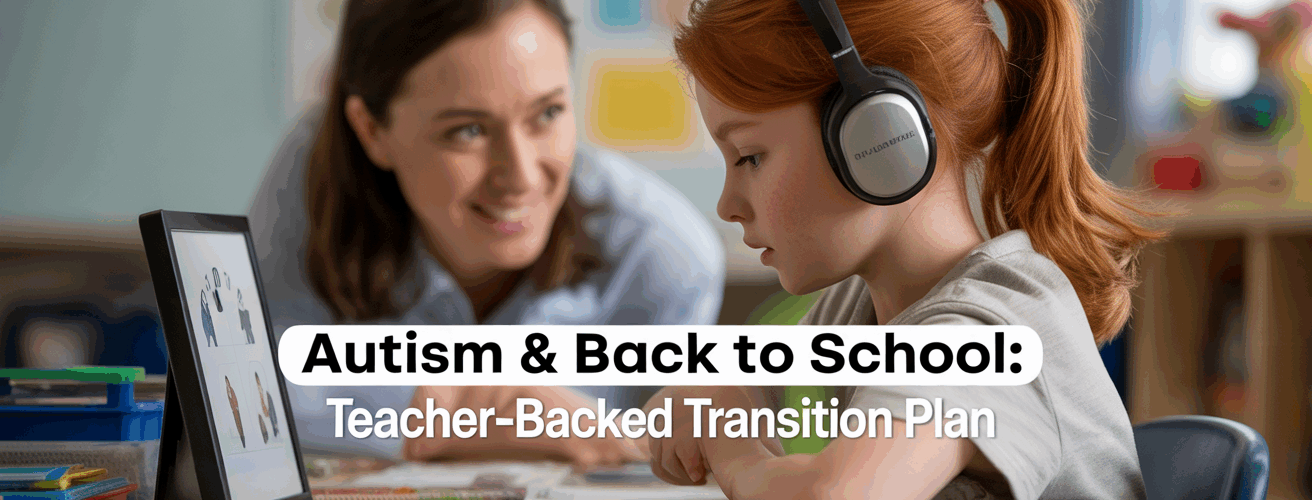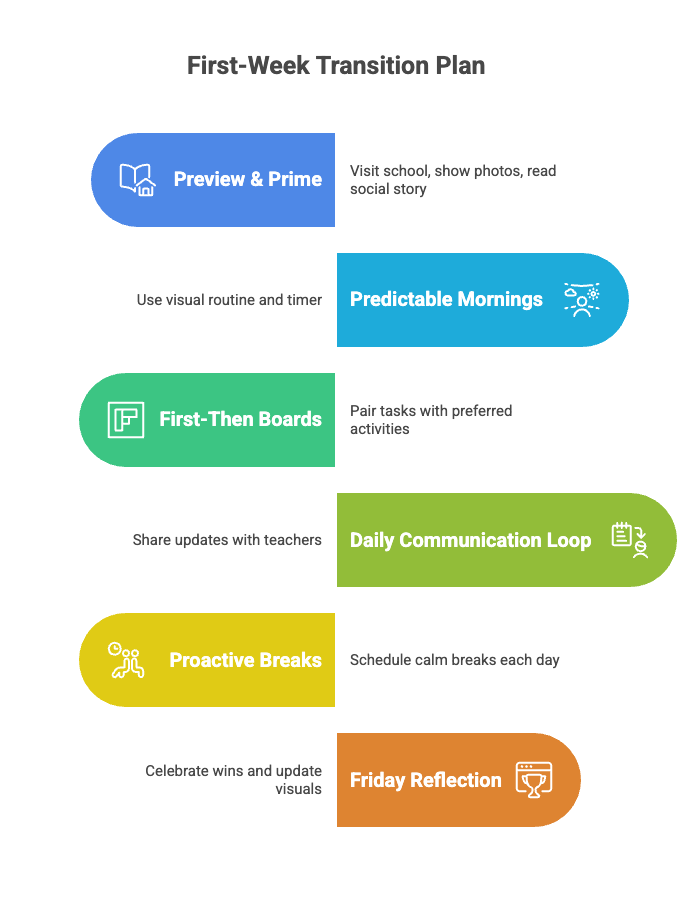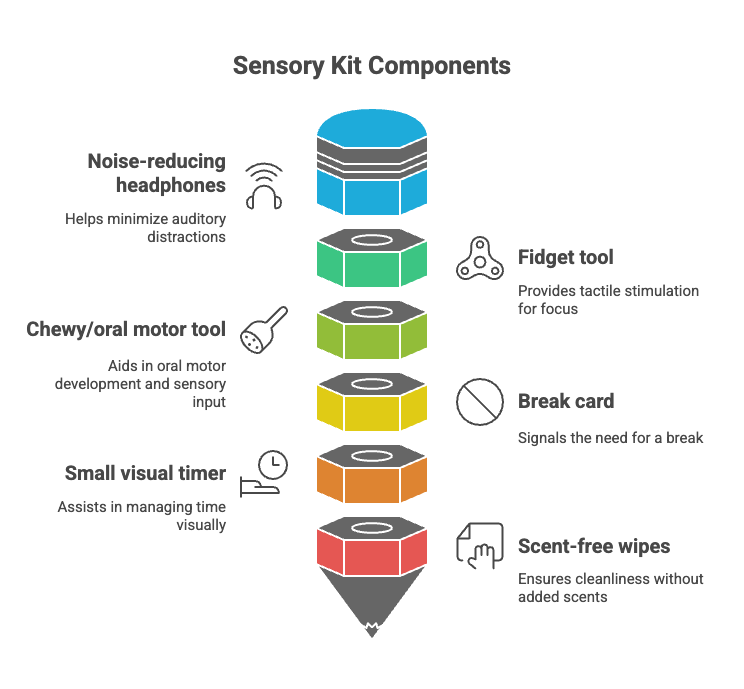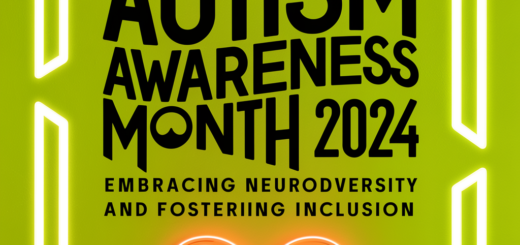Autism & Back to School: Teacher‑Backed Transition Plan (Tools, Scripts, Calm Strategies)

TL;DR (Quick Answers)
- Start 10–14 days early: rehearse morning routines, ride/walk past school, and preview classrooms with photos or a social story.
- Use visuals everywhere: first‑then boards, visual schedules, and visual timers reduce anxiety and improve transitions.
- Pack a small sensory kit: noise‑reducing headphones, fidget, chewy/oral input, and a laminated break card.
- Build a calm corner: low‑arousal space (soft seating, dim light) for 5–10 minute regulation breaks.
- Lock in supports on paper: confirm the IEP/504 accommodations before day one and agree on a home–school communication loop.
Goal: Make the first weeks of school predictable and low‑stress for autistic students by combining visual supports, sensory regulation, and clear home–school teamwork.
Why These Strategies Work (Evidence Snapshot)
Many autistic learners benefit from structure and visual learning. Classroom‑based approaches such as structured teaching (e.g., TEACCH), visual schedules, and predictable routines help students understand what to do, when to do it, and how long it will last. These reduce ambiguity, ease transitions, and support regulation for the school day.
First‑Week Transition Plan (Teacher‑Backed)
- Preview & prime (Weekend before): walk the route, show photos of classroom/cafeteria/bathrooms, read a personalized social story about “My First Week at School.”
- Predictable mornings: use a 4–6 step visual routine; practice wake‑up, dress, breakfast, backpack check, transport. Use a visual timer.
- First‑then for tasks: “First morning work, then choice corner” to scaffold non‑preferred tasks with preferred activities.
- Communication loop: agree on a daily note (or app) with brief checkboxes for mood, meals, breaks, and wins.
- Regulation breaks: schedule two proactive 5‑10 minute breaks (not only reactive ones). Track what works.
- Friday reflection: celebrate micro‑wins, adjust visuals, and update the social story with real photos from the week.
Essential Tools & Supports
- Visual schedules & first‑then boards: daily plan with icons; place at eye level at home and school.
- Calm corner setup: soft seating, minimal visuals, optional weighted lap pad, and clear “how to use” steps.
- Noise‑reducing headphones: wear in cafeteria, assemblies, fire drills, and hall transitions as needed.
- Sensory kit: 1–2 fidgets, oral motor item (if used), scent‑free wipes, break card, and small visual timer.
- Visual timer: shows “time left” to ease transitions.
Comparison Table: Classroom Supports for a Smooth Start
| Support | What It Helps | Best For | How To Use at School | DIY/Cost | Guides |
|---|---|---|---|---|---|
| Visual Schedule | Predictability, transitions | All ages | Mount near student desk; update after each block | DIY printable | CDC visuals |
| First‑Then Board | Task initiation | Primary & middle | Pair non‑preferred with preferred | DIY cardstock | Social Stories™ |
| Noise‑Reducing Headphones | Sensory overload | Cafeteria, assemblies | Offer proactively before loud periods | $$ | Sensory gear picks |
| Weighted Lap Pad | Body awareness, focus | Seat work | Offer for 10–20 min work blocks | DIY/$$ | Weighted guide |
| Calm Corner | Regulation breaks | All ages | Teach “how to break” with visuals; timer | DIY | Autism Society |
| Visual Timer | Transition anxiety | Task endings | Show time left for each activity | $ | Classroom strategies |
Home–School Collaboration (IEP/504, Communication, Consistency)
Confirm supports before day one
- Verify IEP goals/accommodations or Section 504 plan details; ensure staff know “who does what” and where tools are stored.
- Align behavior supports: define proactive breaks, safe adults, and de‑escalation steps; use the same visuals and wording across home and school.
Daily communication that respects time
Use a one‑page daily note or app with checkboxes (mood, meals, breaks used, wins, questions). Keep it specific and solution‑oriented.
Morning & evening bookends
- Morning: predictable wake‑up sequence and a success ritual (e.g., sticker or short choice activity after arrival).
- Evening: rehearse tomorrow’s schedule for 2 minutes; pack backpack with visual checklist; lights‑down routine.
Ready‑to‑Use Scripts
Requesting a break: “I need a quiet break.” (Student shows break card.)
Prompt for transitions: “First math, then drawing. You can set the timer.”
Reinforcing regulation: “You noticed the noise and chose headphones—great self‑advocacy.”
FAQs
How far in advance should we start practicing the school routine?
Are visual schedules only for young students?
What’s the difference between an IEP and a 504 plan?
How long should regulation breaks last?
Related Reading on 101Autism
Watch: Back to School Tips for Autism Classrooms
References
- CDC Autism: Communication Resources & Visuals
- CDC: Treatment & Education Approaches (incl. TEACCH & Visual Learning)
- Autism Speaks: School Community Tool Kit
- Autism Society: Back‑to‑School Resources
- National Autistic Society: Back to School Resources | Social Stories™ Overview
- U.S. Dept. of Education: IEP Guide (PDF) | Section 504 Resource Page | Section 504 FAQ
- DC Public Schools Mental Health: Effective Classroom Strategies for Autism
First-Week Transition Plan

Sensory Kit Checklist for School




3 Responses
[…] See our sensory & weighted picks and our transition planning guide for visual schedules and calm-corner […]
[…] See our sensory & weighted picks and our transition planning guide for visual schedules and calm-corner […]
[…] DIY calm-down corner at home: checklist & printables […]